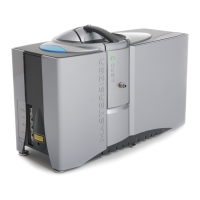Maintenanc e
88
2. Grip the tissue about half way down, dampen the edge of the tissue with a small
quantity of ethanol (too much will flood the tissue). Allow the ethanol to soak in.
3. Note any marks and smears. Inspect the window in reflected light from a fluor-
escent light or other light source.
4. Breathe gently on the window, and allow warm moist air to condense on the
optical surface, to produce an even fog over the window without wet spots. Imme-
diately wipe the whole surface in a single positive action before the condensed
water vapor evaporates. Do not put fingers behind the tissue to press it down; use
the stiffness of the tissue to hold itself against the surface, and curve the tissue to
increase the pressure if necessary. This not only limits the pressure that can be
applied to the surface but prevents grease being dissolved off the fingers and
passed through the tissue and onto the surface.
5. Use each tissue for one pass only as it will become loaded with grease; use of this
tissue a second time will deposit grease back onto the surface. Grit that had pre-
viously been lifted may also scratch it.
6. Re-inspect the window; if it’s still marked, repeat the procedure with a new clean
tissue.
Note: If marks remain, use a liquid cleaner such as Ethanol Absolute or Propan-
2-ol. This can be soaked on a cotton wool bud and wiped across the window
gently. To avoid scratches, after one pass over the window discard the bud. Re-
inspect the window and repeat until clean.

